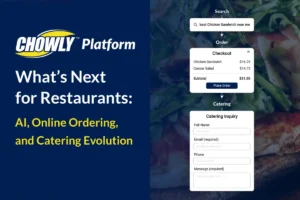When running a business, your job is to have all the answers. How much food should we order? How many hours need to be staffed? What kind of customers do we target? How should we price this item? Is it worth it to add more ordering channels?
The answer to all of these questions almost always lies within the data. But if you’re not collecting it and analyzing it, you’re running your business with one hand tied behind your back.
Look, we know it’s tough to make time to collect and analyze data. Prioritizing something that will help you indirectly in the future over the immediate needs you can meet for customers right in front of you is a difficult balance. Most restaurateurs don’t have the resources to build a true “data stack” for their businesses and instead limp by with an ad hoc system based on a combination of instinct and trial and error. This can work in the early days, but it prevents growth in the long run. Neglecting to incorporate robust data practices into your business model is tantamount to neglecting the key to better business decisions that will improve efficiency, drive growth, and ultimately boost revenue in a way nothing else can.
If you’re a small business owner who owns and operates a restaurant, you know there’s always something to worry about. Between staffing issues, financial concerns, and ensuring that your guests are happy, it can feel like there’s never enough time in the day. But what if there was one thing that you could do to help make your restaurant run more smoothly? And what if that thing didn’t require any extra time or effort on your part after the initial setup? Believe it or not, there is a way to get some valuable insights into your business without spending hours poring over data and hiring expensive agencies. All you need is the right tools. So how can data help your restaurant? Keep reading to find out.
In this article, we’ll discuss two key benefits data can provide in the restaurant business.
Increase Sales
There are only two practical ways to increase your sales: get more orders, or increase your average basket size. You can get more orders relatively simply by just adding more ordering platforms. There are hundreds of ordering platforms out there designed to send you business. Of course, there are the big ones in the news that you know of, but there are also many local ones you may not have heard of. Did you know that an ordering platform called EatStreet does more orders in Wisconsin than any of the big 3 (Grubhub, DoorDash, and UberEats)? And there are more platforms like EatStreet than you think – lesser known but no less powerful platforms.
With data, you can also do more targeting. If you know your customers, you can directly reach them via email or text with offers and reminders or announcements about new items. Imagine if I could give you a list of 10 customers that gave you a 5-star review but haven’t ordered from you in 60+ days? A reminder about a seasonal item, a discount for returning, or a happy birthday message could be what it takes to get them back.
When it comes to basket sizes, there are many ways to increase them. You can increase prices, hit customers with upsells, create combos, create discounts based on total basket size, and many more. But how do you know which items might be under-priced? Which add-ons are most likely to be added at checkout? Which sides create the best combo? This is where data comes in to help you optimize your sales.
Reduce Costs
If you’re a small business owner, you know that every penny counts. So when it comes to reducing your costs, you’ll be surprised how much data can help. In particular, you can reduce food waste and labor costs in your restaurant. Here’s how:
1) Compare inventory levels against sales data to see where there might be opportunities to reduce overstocking of specific items
2) Analyze recipes and portion sizes to ensure that you are preparing the right amount of food for each dish
3) Use customer data to plan menus based on what customers are most likely to order
4) Train employees on proper procedures for ordering, stocking, and preparing food so that less is wasted
5) Audit your supply chain regularly to ensure that you are getting the best deals on ingredients and supplies. Always look at different distributors in your area as they are always hungry to get your business and will be aggressive on fees. Look at joining a group purchasing organization to help share savings with other SMBs near you.
Chowly’s new dashboard is a great place to start by getting a bird’s eye view of your third-party value. There are many other benefits as well, but hopefully, this gives you a taste of how data can help your business.



